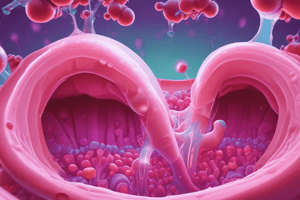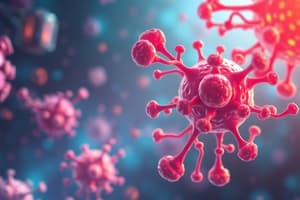Podcast
Questions and Answers
What is the definition of immunogenicity?
What is the definition of immunogenicity?
- The immune response generated by the host against a therapeutic protein (correct)
- The effectiveness of a therapeutic protein in treating diseases
- The level of toxicity in therapeutic proteins
- The ability of a therapeutic protein to bind to its target
Which section of the FDA-approved label contains information about immunogenicity?
Which section of the FDA-approved label contains information about immunogenicity?
- Section 3.1: Drug Interactions
- Section 5.4: Clinical Pharmacology
- Section 6.2: Adverse Reactions (correct)
- Section 6.2: Immunogenicity
What is a characteristic of binding anti-drug antibodies (ADA)?
What is a characteristic of binding anti-drug antibodies (ADA)?
- They can affect the pharmacokinetics of the drug. (correct)
- They are responsible for a complete loss of drug efficacy.
- They exclusively enhance the drug's effectiveness.
- They block the drug's interaction with the target.
What is one of the consequences of neutralizing anti-drug antibodies?
What is one of the consequences of neutralizing anti-drug antibodies?
Why is the study of immunogenicity important in biotherapeutics?
Why is the study of immunogenicity important in biotherapeutics?
What are immune-privileged sites primarily designed to protect?
What are immune-privileged sites primarily designed to protect?
Why is immune privilege in the testis crucial for male fertility?
Why is immune privilege in the testis crucial for male fertility?
How does the mother typically tolerate the presence of fetal antigens during pregnancy?
How does the mother typically tolerate the presence of fetal antigens during pregnancy?
What role do self antigens play in the context of immune privilege in the testis?
What role do self antigens play in the context of immune privilege in the testis?
Which of the following factors contributes to immune privilege in the placenta?
Which of the following factors contributes to immune privilege in the placenta?
What are examples of 'clearing' ADA based on their effects?
What are examples of 'clearing' ADA based on their effects?
What is indicated by the development of ADA in terms of plasma drug concentration?
What is indicated by the development of ADA in terms of plasma drug concentration?
How are non-clearing ADA commonly described?
How are non-clearing ADA commonly described?
Which type of T cells promote ADA generation?
Which type of T cells promote ADA generation?
What is considered a driver of immunogenic response in T cells?
What is considered a driver of immunogenic response in T cells?
What is the role of Treg cells in relation to ADA?
What is the role of Treg cells in relation to ADA?
What are T cell epitopes and Tregitopes related to?
What are T cell epitopes and Tregitopes related to?
What is a typical expectation concerning plasma drug concentrations with multiple dosing?
What is a typical expectation concerning plasma drug concentrations with multiple dosing?
What role do dendritic cells (DCs) play in the lamina propria?
What role do dendritic cells (DCs) play in the lamina propria?
Which cytokines are important for the differentiation of bacterial antigen-specific Th17 cells?
Which cytokines are important for the differentiation of bacterial antigen-specific Th17 cells?
What promotes the differentiation of bacterial antigen-specific regulatory T cells (Tregs)?
What promotes the differentiation of bacterial antigen-specific regulatory T cells (Tregs)?
How do keratinocytes contribute to the immune response in the epidermis?
How do keratinocytes contribute to the immune response in the epidermis?
Where do the skin-homing properties of effector lymphocytes develop?
Where do the skin-homing properties of effector lymphocytes develop?
Which signaling factors are involved in the migration of effector T cells into the skin?
Which signaling factors are involved in the migration of effector T cells into the skin?
What is the primary function of the epidermis in relation to microbes?
What is the primary function of the epidermis in relation to microbes?
What initiates the expression of CCR10 in the skin?
What initiates the expression of CCR10 in the skin?
What is the role of intestinal epithelial cells in the gastrointestinal immune system?
What is the role of intestinal epithelial cells in the gastrointestinal immune system?
Where are M cells primarily located within the gut?
Where are M cells primarily located within the gut?
What distinguishes M cells from absorptive epithelial cells?
What distinguishes M cells from absorptive epithelial cells?
What characteristic role do the lymphocytes play following their differentiation in lymphoid tissues?
What characteristic role do the lymphocytes play following their differentiation in lymphoid tissues?
What type of tissues induce dendritic cells in the gut?
What type of tissues induce dendritic cells in the gut?
What is the primary composition of the gastrointestinal system's structure?
What is the primary composition of the gastrointestinal system's structure?
Which of the following statements about M cells is true?
Which of the following statements about M cells is true?
What function does the lamina propria serve in relation to the epithelial layer?
What function does the lamina propria serve in relation to the epithelial layer?
Flashcards are hidden until you start studying
Study Notes
Immunogenicity
- Immunogenicity is the host immune response against a therapeutic protein
- Typically, immunogenicity is studied in the context of anti-drug antibody (ADA) formation
- All FDA-approved biotherapeutics include a section on immunogenicity in their label (section 6.2) under Adverse Reactions
Anti-Drug Antibodies
- There are two main classes of ADAs: binding and neutralizing
- Binding ADAs interact with the drug molecule but do not inhibit its binding to the pharmacologic target
- Binding ADAs may impact pharmacokinetics and safety
Neutralizing ADAs
- Neutralizing ADAs directly block the interaction of a drug with its pharmacologic target
- Neutralizing ADAs result in loss of efficacy, impact pharmacokinetics, and may impact safety
'Clearing' ADAs
- Both binding and neutralizing ADAs can be categorized as 'clearing'
- 'Clearing' ADAs are detected based on their effects on pharmacokinetics
- Non-clearing ADAs are also referred to as 'sustaining' ADAs
- A typical expectation is a rapid decrease in plasma drug concentrations upon ADA development
- Decreased plasma concentrations following multiple dosing (typical expectation is accumulation)
Physiologic Drivers of Immunogenicity
- Immunogenicity is largely thought to be a T-cell dependent phenomenon
- The context of presentation to T cells is likely a driver of the ultimate response
- Presentation to T helper cells leads to ADA generation
- Presentation to Treg cells limits ADA generation
The Gastrointestinal Immune System
- Intestinal epithelial cells lining the small and large bowel are part of the gastrointestinal innate immune system involved in responses to pathogens and antigen sampling
- The gastrointestinal system is a tube-like structure lined by a continuous epithelial cell layer that serves as a physical barrier
- The lamina propria underlies the epithelium, containing blood vessels, lymphatic vessels, and MALTs
M Cells
- M cells are located in regions of the gut epithelium called follicle-associated (or dome) epithelium
- Antigen may be delivered from the lumen to the GALT through specialized cells called M cells
- M cells have a thin glycocalyx, short irregular microvilli, and large fenestrations in their membranes, enhancing antigen uptake from the gut lumen
Homing Properties of Intestinal Lymphocytes
- The gut-homing properties of effector lymphocytes are imprinted in lymphoid tissues
- DCs in GALT are induced by cytokines
- DCs in the lamina propria take up and process protein antigens from microbes and transport them to mesenteric lymph nodes
Effector and Regulatory T Cells in the Intestinal Mucosa
- Different subsets of effector CD4+ T cells in the gastrointestinal tract are induced by and protect against different microbial species
- Th17 effector T cells and regulatory T cells are abundant in the intestinal mucosa
- Bacterial antigen-specific Th17 cells differentiate from naive CD4+ T cells in GALT in response to antigens presented by DCs
- Differentiation of bacterial antigen-specific regulatory T cells is promoted by TGF-β and retinoic acid
- Thymic Tregs that migrate to the intestine expand under the influence of bacterial metabolites
The Cutaneous Immune System
- The epidermis provides a physical barrier to microbial invasion
- The epidermis is made up of keratinocytes
- Keratinocytes actively respond to pathogens by producing antimicrobial peptides and cytokines
Homing Properties of Cutaneous Lymphocytes
- The skin-homing properties of effector lymphocytes are imprinted in skin-draining lymph nodes
- Ultraviolet rays in sunlight stimulate vitamin D production
- IL-12 induces the expression of E-selectin ligand CLA, and other signals induce CCR4, CCR8, and CCR10 expression
Immune-Privileged Tissues
- Immune responses and associated inflammation in certain parts of the body, including brain, eye, testes, placenta, and fetus, carry a high risk for lethal organ dysfunction
- These tissues are called immune-privileged sites
Immune Privilege in the Testis
- Immune privilege in the testes limits inflammation that may impair male fertility
- Many self-antigens in the testes are first expressed at puberty, so it is unlikely lymphocytes specific for these antigens are deleted during development
- Immune privilege in the testes may also prevent autoimmunity
Immune Privilege and the Fetus
- The fetus expresses paternally inherited genes that are foreign to the mother
- The mother is exposed to fetal antigens during pregnancy, and maternal antibodies against paternal MHC molecules are detectable
- Different molecular and barrier features of the placenta contribute to immune privilege in the fetus
Studying That Suits You
Use AI to generate personalized quizzes and flashcards to suit your learning preferences.




